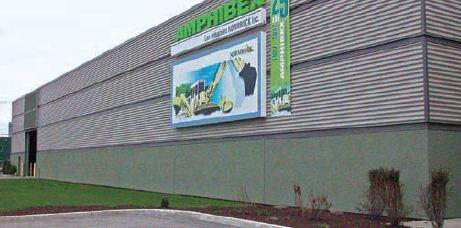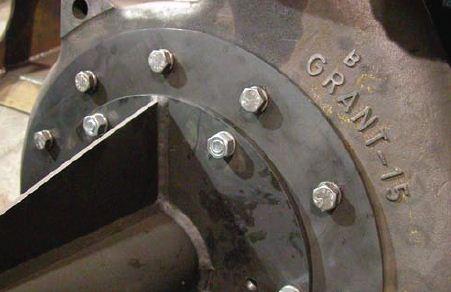- FMA
- The Fabricator
- FABTECH
- Canadian Metalworking
SME success stories: Amphibious ambitions
Normrock Industries dredges the world with innovative technology.
- By Nick Healey
- August 20, 2014
- Article
- Fabricating
Canada has a strong history of unique and important inventions. They can be as simple as five-pin bowling, or high impact game-changers like insulin or the pacemaker. Now, another invention by a Montreal company, is well on their way to winding up in a group with the latter.”
Normrock Industries, the makers of Amphibex dredging equipment have come up with a great idea for an obvious problem within the industry – mobilization.
Up until fairly recently, and currently in a lot of cases, dredging has been done the old-fashioned way. Excavators and similar types of equipment are hooked up to barges and moved around with tugboats, or other rudimentary propulsion methods.
But with Amphibex equipment these days of slow, arduous dredging practices are beginning to be phased out.
“It started because of the need for this type of machine,” says founder and president, Norman Grant.
“We were in dredging and excavation, and dredging with big machines in the centre of a river, it’s okay, but then you have to dredge your way to the shore, otherwise you’re stuck in the middle.
“We just wanted to fill the gap between regular dredging and land excavation.”
This truly global company was founded in 1987 by the elder Grant and it remains a family-run business to this day, with his two sons Dany and Jimmy, now key figures in the shop’s operation, and his wife Louise running the finance side of the business.
The affable Norman, Dany and Jimmy, sit in the boardroom of their 45,000 square foot facility in Terrebonne, a huge world map sprawled out behind them with pins stuck to many exotic locales where their dredging equipment has become a staple.
“We have some in China, Turkey, Romania, Iraq,” Norman says. “We’re working on Argentina right now, we have some in Mexico, St. Maarten.” And that list doesn’t include the other pins stuck to Russia, Senegal, and even New Caledonia in the South Pacific.
The beauty of the machine is in its simplicity. While it looks fairly unique – the hydraulic legs, and pontoon floats make it resemble some sort of grasshopper-like insect – mostly, it’s designed to be simple to use, maintain, and repair. All of the machine’s moving parts are hydraulic, making them much easier to fix in some of the remote locations the Amphibexes find themselves in.
The machines range in size, starting from the 400 model, running up through the 600, 650, 800, 1000, and most recently 1200.
They also make a transport vehicle – the Amphitransport AT300 – for moving containers of waste material when necessary.
“We’re facing a demand for larger equipment – especially in North America. We developed the 1200 and they’re not going to be able to ask for more because it bears a 30-inch pump! 44,000 gallons per minute,” Norman says.
[gallery type="slideshow" link="none" ids="105133,105134"]
Grant claims the machines don’t need to get bigger to be more effective, but he laughs when Dany reminds him that every time he says that, they go up another size.
“The machines keep growing. A small one was 37 feet long by 11 and a half feet wide, and now the (latest) model is going to be 60 feet long and 28 feet wide,” Dany says.
Currently, the company has about 60 employees who work on the machines, and along with their 12 engineering staff they do all of their own R&D in house.
The machines vary in cost, from about $1.35 million for a small one, and up to $6 million for their largest models. There is also a variety of custom options for the excavating equipment.
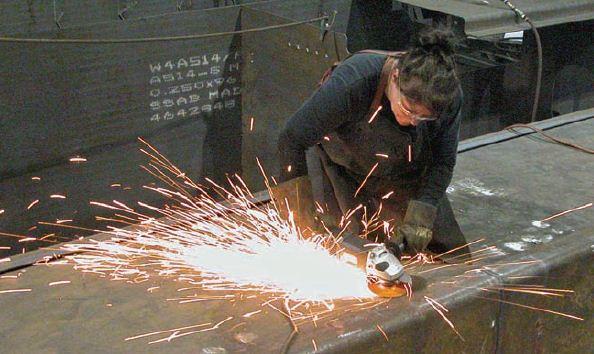
Martine Henry grinds down a weld on an unfinished Amphibex. Executive Vice President Dany Grant claims that women are some of the company’s best employees.
“From scratch – ordering the steel – it takes about 4-5 months depending on the machine,” Norman says. “But we have pretty good orders so we build 4, 5, or 6 together.”
“Every piece of steel on the machine has a serial number and we know the mill test and everything.”
The steel on the sides and the top is 3/16th, while the bottom uses 1/4 –inch, so clearly the machines are durable – probably important when you are sometimes floating through rock and ice.
“The smaller one has nine compartments (for floatation). If we hit a rock, the rock’s going to suffer!” Norman jokes.
And of course, with that much steel being used, it’s obviously the type of work that lends itself to a lot of welding and grinding applications.
Dany credits their beveling equipment as a time saver. “Without that we’d use a lot more stuff from Walter. Still, we need the hand grinders also. We’re using 5-inch (disc). It’s easier to handle, and it goes everywhere,” he says.
The Grants also credit their use of flux-cored welding wire for speeding up the process. They claim it works best in vertical and overhead situations, and that deposition rates work well for their projects.
The company has also added a new facility about 10 minutes down the road. They plan to use the new building to do a lot of the final assembly of the parts – especially on the bigger models.
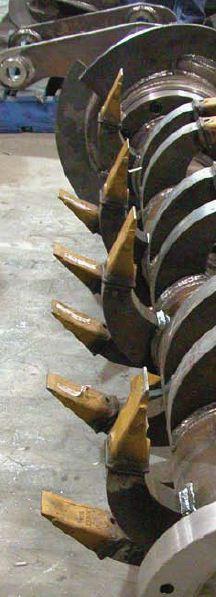
An example of one of the many attachments that can be used on an Amphibex. Applications for the machine range from traditional dredging to ice breaking.
One of the other features of the business is their environmental ethos. Both on their website and in person the Grants are quick to point out the value of the machines from an environmental perspective. Often, dredging is thought of as a destructive and unnatural process used more for the sake of human comfort than anything else. However, the dredgers are often used for decontamination projects, including one where the machines pulled up 19 kilos of mercury from contaminated soil in a river bed.
In Senegal there was also an environmental project example where they supplied equipment for one section of the Senegal River. “No water was coming out of that (area),” Norman explains. “There was not enough unsalted water coming into it, so the sea water was coming up, the city of St. Louis had salt water as drinking water… once they opened that up, it was fine.”
Of course there is a massive range of applications for the machine, and some of the other jobs happen a little closer to home. The Red River in Manitoba has always struggled with the spring thaw and the massive amount of ice it sees – a job requiring seriously durable equipment.
“It’s very, very rugged equipment – we’re breaking ice with it,” Norman says. “On the Red River in Manitoba they have four of our machines and they’re breaking ice every spring, to prevent ice build-up and flooding.”
A number of Amphibex machines have also already made their way to the oilsands in western Canada, for use in the basins.
Then sometimes the reason they’re called upon drifts into the territory of the completely bizarre – like pirate-hunting.
“In Saudi Arabia they’re grinding part of the coral reef because the coast guard can’t get in. There are pirates, they hide (in the reef) so the coast guard can’t chase them! It’s surprising the type of jobs (we do),” Norman says.
It’s clear in the way the Grants talk that they have a real passion for their business and enjoy getting involved in projects and offering their expertise.
“People come with their problem, they ask us if we can do something and we try to find the solution,” Dany says.
The funny thing about solutions though is that sometimes the simplest ones are the best answer – something Normrock has clearly discovered with their unique invention.
About the Author
subscribe now


Keep up to date with the latest news, events, and technology for all things metal from our pair of monthly magazines written specifically for Canadian manufacturers!
Start Your Free Subscription- Trending Articles
CWB Group launches full-cycle assessment and training program

Achieving success with mechanized plasma cutting

3D laser tube cutting system available in 3, 4, or 5 kW

Brushless copper tubing cutter adjusts to ODs up to 2-1/8 in.

Welding system features four advanced MIG/MAG WeldModes
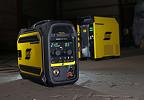
- Industry Events
MME Winnipeg
- April 30, 2024
- Winnipeg, ON Canada
CTMA Economic Uncertainty: Helping You Navigate Windsor Seminar
- April 30, 2024
- Windsor, ON Canada
CTMA Economic Uncertainty: Helping You Navigate Kitchener Seminar
- May 2, 2024
- Kitchener, ON Canada
Automate 2024
- May 6 - 9, 2024
- Chicago, IL
ANCA Open House
- May 7 - 8, 2024
- Wixom, MI














